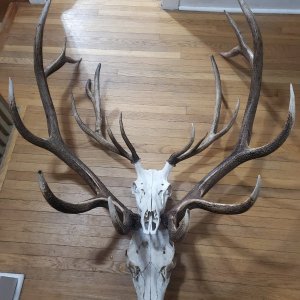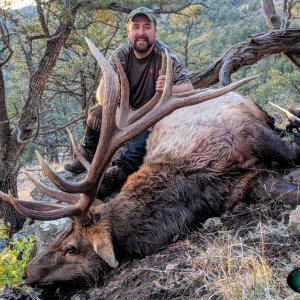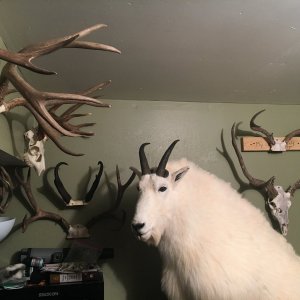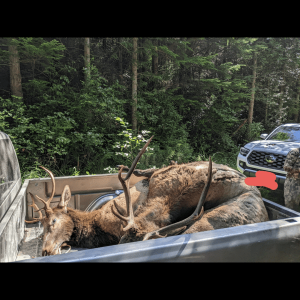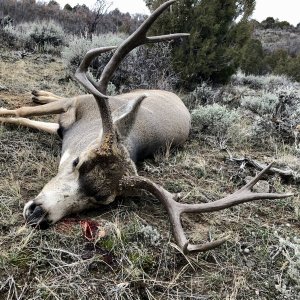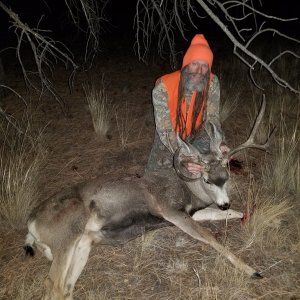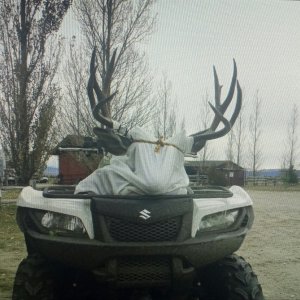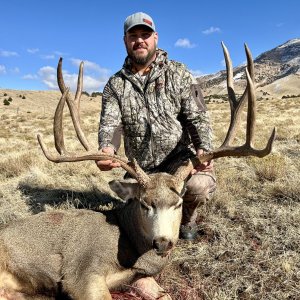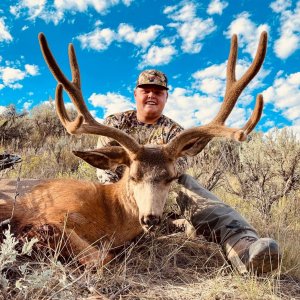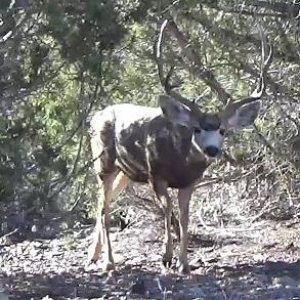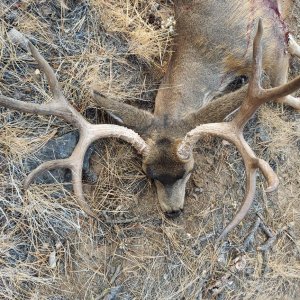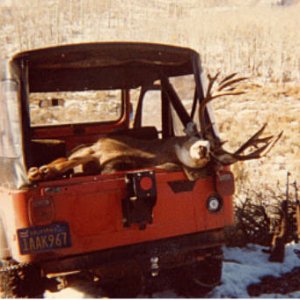Wait Till Niller Reads this!
Hill Isn't Talking Cutting Tags!
He's Sayin To Close It For 3-5 Years!
How Bout Them Apples Niller?
Take a look at the disease element section below:
Colorado Mule Deer in 2021
Mike Duplan
Decisions made from afar can have dire consequences on mule deer.
There’s a familiar conversation about mule deer that we have heard before and seems to have become more frequently heard again. Mule deer numbers are down, and the deer hunting isn’t what it used to be. The concern isn’t limited to certain places and states but is instead an issue that is seen from the Sonoran Desert to the plains of Alberta and from the coulees of Eastern Colorado to the far western edge of mule deer range in the California Sierras.
Most recently, a downturn in mule deer numbers and hunting quality in Colorado seems to be quite the topic of conversation in hunting circles. This is probably because, one, the state is on the decline, and two, Colorado has always been the go-to state for both opportunity and quality of bucks. Problems mule deer face are not limited to Colorado, and the issues faced by both the species and by hunters deserve a serious conversation.
Recently I was a guest on a podcast with Jason Carter and Adam Bronson of Epic Outdoors. We discussed mule deer hunting in general along with Colorado’s current mule deer hunting conditions and potential. What they both agreed on was they field more questions on Colorado deer applications than any other state or species. We also agreed that there is not a single go-to unit, season, or area in the state where a hunter has a reasonable chance of taking a buck that would justify 20 years’ worth of applications and preference point accumulation. Mature buck numbers are down, and quality hunting opportunities are not commensurate with a perceived preference point value.
Words from an Expert
I recently had a candid discussion about mule deer in the Middle Park region with Clay Hill of Hill Guides and Outfitters in Kremmling, Colorado. Clay and his family have been ranching and outfitting in the area for over 40 years, and when I asked him about the current quality of bucks in Middle Park, he said, “It’s the worst I’ve seen in my entire life. My dad says it’s worse than the ’80s and early ‘90s when it was bad. I’ve talked to locals about the deer, and everyone is in complete agreement. Mature bucks are nearly non-existent. I haven’t heard of a single 180-class mule deer on the winter range this year, and many avid shed hunters in the area watch deer.”
When asked about what he thinks is the issue, Clay said, “That’s simple. Too many tags and hunters these days are too good. The CWD excuse doesn’t hold water with me as I personally have never seen a single sick animal, and the positive test result prevalence is very low. We as hunters have killed way too many bucks for too many years. It’s at the point where I would actually like to see them shut down buck hunting for 3-5 years.”
Those are strong words and hold a very pessimistic outlook for that area, but Colorado’s deer woes aren’t limited to Middle Park. The neighboring Eagle County is hailed as the best Colorado deer hunting and has historically been one of, if not the top county for Boone & Crockett mule deer in the entire country. Record-book-eligible deer taken from Eagle county are not often seen these days, but that trend seems to be the norm in Colorado now. In the four years between 2004 and 2007, there were 131 typical B&C bucks taken in Colorado. During the most recent four-year span, there were 37 taken. That’s 350% more Boone & Crockett bucks taken during the 04-07 time period than in the last four years. While B&C entries aren’t the statistical gold standard for mule deer buck age class representation in a herd, there is a reasonable, common-sense correlation to a given percentage of mature bucks that will qualify for B&C out of a sample of mature bucks taken in an area with a genetic potential to produce them. The obvious answer is that there are not as many mature bucks in Colorado as there have been in recent years.

Local Evidence
Anecdotal statements from taxidermists all over bear a similar theme. Mature bucks from Colorado have become rare. No longer are there stacks of nice buck racks in taxidermy shops, ready for mounting. Instead, a small handful trickle in from random hunters lucky enough to cross paths with what seems to be an almost unicorn-like animal on the Western Slope of Colorado. One taxidermist I talked to, who wished to remain anonymous, said this: “Fifteen years ago I would have a stack of damn nice bucks in my shop every winter after season, and there were enough big deer killed that some hunters were electing to do European skull mounts of their bucks and sell me the capes to use. Now, I can count the nice bucks I get on one hand and sometimes not use all the fingers. I can’t even find capes to buy when someone has an old mount they want re-done. It’s not just me. I hear the same story from every taxidermist I know.”
Randy Clark, owner of the renowned Traders Rendezvous in Gunnison, Colorado, has lived most of his life in the Gunnison Basin and has been in the hunting business for decades. He says deer hunting in the area is an item of concern and controversy. Randy states that hunters with stacks of preference points have drawn buck tags in the surrounding units of the “Basin” which are, in theory, managed for quality, not quantity, and have been for over 20 years.
Clark says, “I feel really bad for some of these hunters who have drawn their “Dream Tag” only to come hunting in the area and have trouble finding a mature mule deer. Quite simply put, the state is issuing too many tags, and we are overharvesting our mature bucks and have been so for a few years now. The winter range tells the story. We have a very open, visible, and confined winter range in the Gunnison Basin, so it’s very easy to see what is out there. The giants of the early 2000s are gone, and the bucks we have now just aren’t living long enough, on average, to reach their potential. I know it might not ever be the same as what it was 15 years ago, but I find it truly sad to know that there aren’t many mature mule deer on the landscape anymore.”
Common-Sense Evidence
I consider the Boone & Crockett record book to be a fair barometer of the quality of mule deer hunting in Colorado. It’s quite rare for a hunter to kill more than one in a lifetime, so when hunters do manage to kill a B&C-class buck, I feel like they are more likely than ever before to have it measured and entered. B&C-class mule deer bucks are anomalies in general, for they are rare and uncommon. But I do feel like it is a fair statement to say that they do make up a certain percentage of mature deer, in varying numbers, depending on the local genetic potential and buck numbers if an area has the potential to produce B&C-class deer and has done so historically, yet the number of entries has dropped substantially. A reasonable person can assume that there are far fewer mature bucks in general in the area. Barring a severe winter, hunting is the primary mortality factor in buck numbers, and when we, as hunters, kill too many, both the age class and the buck-to-doe ratio suffer.

The Disease Element
Chronic Wasting Disease, known as CWD, is a major factor in mule deer management in Colorado right now. Recently, an attempt has been made to curb the spread and prevalence of CWD in some of Colorado’s deer units by increasing the hunting pressure and buck harvest. In conversations with state wildlife employees that I’ve talked to, the basic premise is that older age class and more mature mule deer are active and mobile during the rut and tend to move from doe group to doe group looking for does in estrus to breed. These bucks have a higher chance of being exposed to CWD, contracting it, and thus spreading it. Buck tag numbers in many areas that have had deer test positive for CWD have been increased dramatically, and in just a few short years, bucks over 2.5 years of age have been wiped out.
Most deer rarely live beyond 10 years of age, so if you have reduced transmission by fewer mature bucks and natural attrition of infected deer, there’s hope that CWD spread will be controlled and infection rates will drop. It’s a hopeful theory that has some research to support the plan, but it truly flies in the face of common sense and is simply not guaranteed to work. You and I, as armchair biologists, have received enough communicable disease infection information in the last year to see that these infectious diseases simply do not go away easily enough. Wherever drastic measures have been taken to control an outbreak, they simply slow the spread but don’t eliminate it. Most places and societies end up with the same infection and death rates eventually in different time frames. The bottom line on CWD is that we are taking incredibly drastic measures on deer herds to combat a disease that hasn’t shown to have more than a single-digit infection rate. Most animals that test positive don’t appear sick, and it’s a disease that still hasn’t infected or killed a single human to date via the consumption of venison.


